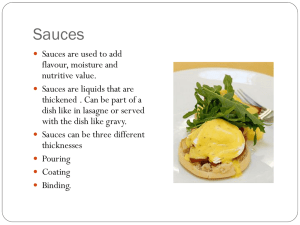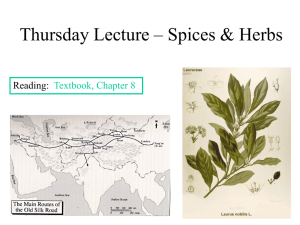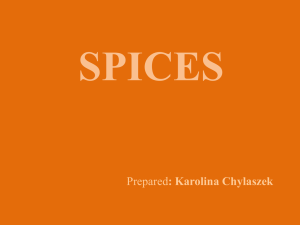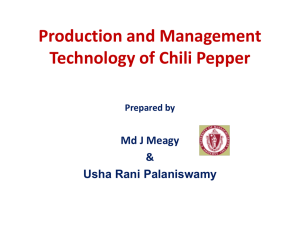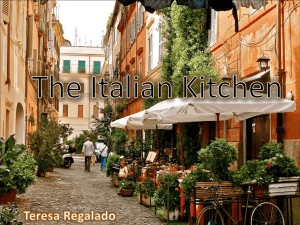Adding Taste - Sweden
advertisement
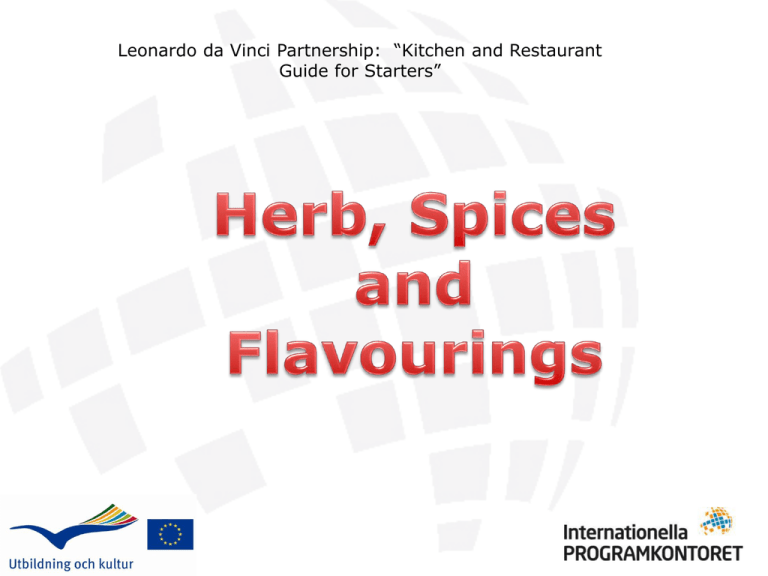
Leonardo da Vinci Partnership: “Kitchen and Restaurant Guide for Starters” Herbs • Herbs refer to leaves from plants that are used when cooking. • The leaves can either be used freshly plucked from a plant or they can be dried for later use. • Oil from the leaves create an odor which in turn is transferred the food. • Herbs stimulate gastric juices that are part of the digestive process. Basil • Basil is known for its pungent taste and sweet smell. It goes well with tomatoes. It is an important of pesto sauce and can be found in some salads. Bay Leaf • Bay leaves are large leaves by herbal standards. They are not chopped in to small pieces like other herbs often are when dried. The leaf is used in many sauces, soups and stews as well as with fish and vegetable dishes. Chive • Chives belong to the onion family and they look like thin reeds. They are commonly used for an onion flavour in hors d’oeuvre and salads. Additionally, they are used in fish, meat and poultry dishes and as garnish with soups. Coriander • Coriander leaves look a lot like parsley and have a very recognizable pungent taste. Coriander is also a spice, but that comes from another part of the plant. Dill • Dill leaves are numerous and thin and so it resembles a green-grey feather. Dill is used for pickles as well as in fish and seafood dishes. Fennel • Fennel, like dill, looks like a feather, but is fuller and greener. Fennel is also used in fish dishes; however, fennel can be found in meat dishes and salads too. Marjoram • Marjoram is sweet and versatile. In its dried state, it is used most often in sauces, soups and stews. Fresh, it is used with cheese, fish, pork, poultry and vegetable dishes. Oregano • Oregano has a strong and distinctive aroma. The flavour is tangy. Oregano is used heavily in Greek and Italian cooking. In addition, it is used in meat, pasta and vegetable dishes as well as in salads, suaces and soups. Parsley • Parsley is widely used as garnish, but is also used to flavour a large assortment of dishes. Rosemary • Because rosemary has a strong fragance, it is used in smaller quantities. It is often put on grilled or roasted dishes while the dishes are being cooked. It can also be found in salads, sauces and stews. Sage • Since sage helps the digestive system handle rich fatty meat, it is a wellknown ingredient in stuffings for pork and poultry. Sage has an intense, pungent flavour. Tarragon • Best used fresh, tarragon is used in sauces, such as béarnaise sauce. Tarragon can be found in omlettes and salads as well as fish and meat dishes. Thyme • Thyme is another versatile herb and blends well with other herbs since it does not have an overpowering flavour. Thyme is used in salads, sauces, soups, stews and stuffings. It is also sometimes mixed with vegetables. Spices • Spices, like herbs, have oils that help the digestive system since the oils stimulate the production of gastric juices. • Spices come from – Bark: cinnamon – Flowers: cloves, saffron – Fruits: chillis, paprika, peppercorn – Roots: ginger, turmeric – Seeds: cardamom, coriander, cumin, nutmeg • Well-known powders are made from a mix of spices Spices from Bark Cinnamon • Cinnamon is most often used in a powdered form in baked goods. Cinnamon sticks, rolled pieces of dried bark, are also used at times to add the distinctive taste to other dishes Spices from Flowers Cloves Saffron • Cloves are actually unopened flower buds. The buds are used to add flavour to sauces and stocks as well as mulled wine. Cloves are also used as studs in roasting ham. • The stigmas from the crocus flower are dried to produce saffron. Saffron does not only add flavour, but also colour, a distinctive yellow. Rice dishes sometimes have saffron, which is also used sauces and soup. Spices from Fruits Chilli peppers Pepper(corn) • Chilli peppers come in many different colours, sizes and heat. The spice paprika comes from the chilli, capsicum. Chillis are used heavily in Indian, Mexican and Thai cooking. Pasta dishes and pizza often make use of chillis too. • Pepper is a strong spice that comes from the dried fruits of pepper plants. There are different kinds of pepper like black pepper and white pepper. They all come from different plants. Pepper is also used to enhance the taste of food. Spices from Roots Ginger Turmeric • Ginger is from a tropical lily. Ginger has a strong, slightly pungent, sweet, aromatic flavour. As a powder, it is used for bakery items and also mixed with other spices. The root can be cut up and used in stir-fry dishes and sauces. • Turmeric is used mainly as a colouring agent in curry since turmeric does not have much flavour on its own. In other words, the root is ground into a powder and mixed with other spices or used to colour dishes yellow. Spices from Seeds Cardamom Coriander • In cooking, cardamon is most often ground into a powder and used in sweets or baked goods. It has a unique, strong taste which comes from its intense aroma. It is often found in curry. • The seeds are crushed into a powder which has a citrus-like taste. The powder is blended with other spices, such as curry. It is also used in sauces. Spices from Seeds Cumin Nutmeg • Cumin is the second most used spice in the world after pepper. It is used in curry mixtures, Mexican cuisine and many other cultures. It has a powerful taste, oily, warm and sweet. • Nutmeg is used in ground or grated form. It has a sweet flavour and is used in sauces and soups. It can be found in cheese and vegetable dishes as well. Like many other spices, it can be blended with other spices. Spices that are blended Curry • Curry actually comes in many different blends with different colours; however, curry powder typically contains coriander, cumin, fenugreek, turmeric and paprika. Cardamom, fennel and cinnamon are often mixed in as well. It’s not unheard of to find curry powders with nutmeg or cayenne pepper. Chilli Powder • Chilli powder is another often used mixture of spices. It is used commonly in Thai and Tex-Mex. The mixture typcially contains dried and crushed chilli peppers, cumin, garlic powder and oregano. SALT • Salt is a kind of mineral composed of sodium chloride. Salt is a seasoning that is in the form of powders and are used to enhance the flavour of food. Pictures in the presentation are taken from the public domain via the Internet. The presentations are used for non-profit educational purposes.
